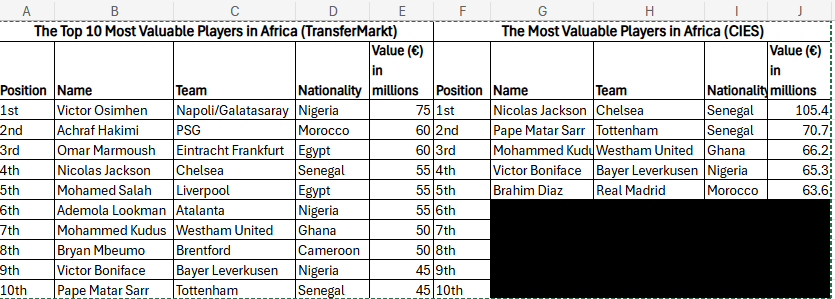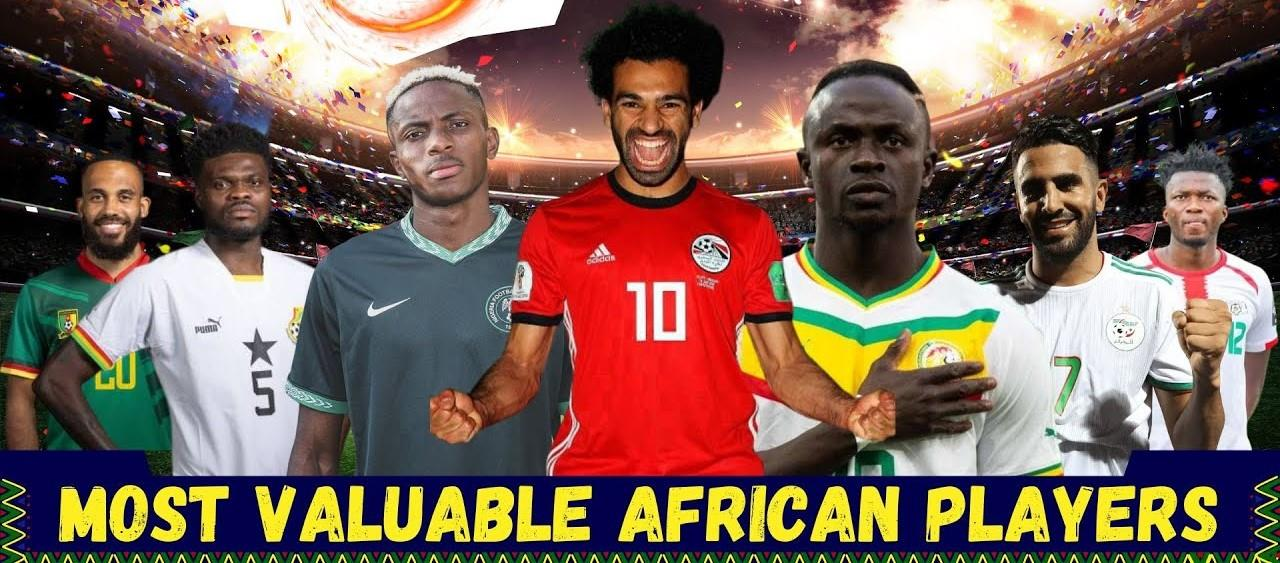Transfermarkt’s latest valuations have elevated Vinicius Jr to join Erling Haaland as the most valuable footballer in the world. Previously tied with his Real Madrid teammates Jude
Bellingham and Kylian Mbappe, all valued at €180 million (£152 million), the Brazilian winger has now surged ahead with a value of €200 million (£166 million).
According to the Transfermarkt model, Victor Osimhen is currently the most valuable African player in 2025, with an estimated worth of €75 million, ranking 36th overall.
In a world where Rodri holds the Ballon d’Or and Vinicius has been named FIFA’s The Best, Jude Bellingham tops the International Centre for Sports Studies (CIES) player ranking. The Real Madrid midfielder is valued at €251 million ($258.58 million), while Manchester City’s
Erling Haaland, his closest competitor, is valued at €221 million ($227.6 million). Vinicius, who finished second in the Ballon d’Or voting and claimed FIFA The Best, rounds out the top three with a value of €205 million. No other players outside the top three reach the €200
million mark. Barcelona’s Lamine Yamal comes in fourth at €180 million, ahead of Kylian Mbappé, whose value is €175 million.
Despite winning the Ballon d’Or, Rodri ranks much lower, in 73rd place. His age (he turns 29 in June) and recent cruciate ligament injury may have contributed to his drop in value. CIES has valued him at €70.6 million. In the goalkeeper category, Brighton’s Bart Verbruggen holds the highest value, while Manchester City’s Josko Gvardiol is the most valuable defender. Viktor Gyökeres, of Sporting CP, tops the list for players outside the top 5 European leagues. As for African players, CIES ranks Nicholas Jackson as the most valuable, placing him 22nd with a €105
million valuation.
These valuations are influenced by factors such as age, performance, salary, contract
length, and the identities of the buying and selling clubs, which naturally favors players from top-tier teams and leagues.

Recently, football transfers seem to have gotten completely out of hand. It feels like just yesterday that Gareth Bale became the first player ever to be valued at €100 million. Nowadays, such sums are becoming almost routine.
Considering that €100 million now often lands you a 21-year-old with limited top-flight experience, just imagine how much it would take to secure the world’s best players.
Which model offers a true valuation of the player’s market value?
Transfermarkt uses the Estimated Transfer Value (ETV) on their Player Valuation Model. The Estimated Transfer Value (ETV) in a player valuation model refers to the projected market value of a football player if they were to be transferred from one club to another. It is
typically used by clubs, analysts, and scouts to understand a player’s worth in the transfer market based on various factors such as:
ETV is generally calculated using advanced statistical models, historical data, market conditions, and various inputs, such as scouting reports, player development curves, and club strategies.
The CIES Football Observatory is a global leader in the scientific evaluation of professional players’ transfer values. They use advanced statistical modeling to assess the factors thatmarket actors consider when determining the transfer prices of professional football players.
Their econometric approach, which was originally developed to evaluate the transfer prices of players under contract with their clubs, is now applied on a global scale.
CIES’ model demonstrates that transfer market price formation is more rational and statistically predictable than commonly assumed by the public.
While the weight of various price determinants can vary from one transfer to another, certain unquantifiable factors may also influence player value. Their criteria include :
- Contract details
- Age
- Sporting level
- Domestic playing time
- International playing time
- Goals
- Results
- Starting XI appearances
- Position
- International status
- Selling potential of the releasing club
- Selling potential of the releasing league
- Buying potential of the destination club
- Buying potential of the destination league
Since the COVID-19 pandemic, the age factor has become even more significant, with an increasing number of clubs focusing their recruitment on younger players to make capital gains through future transfers. This has contributed to greater inflation in the market value
of players under 23 compared to older players. Debates surrounding market values are common in the football world, with fans, coaches, and sporting directors often holding differing opinions on a player’s worth. These discussions also reflect the different methodologies used to estimate the fair market value
of footballers, who are the most valuable assets for football clubs. A key distinction lies between the approaches of CIES and Transfermarkt. While Transfermarkt is known for its user-generated content, where valuations often reflect
collective opinions, CIES relies on data-driven analytics and statistical models to assess player values, resulting in what may be a more objective approach. One major difference between the two is that CIES’ valuations account for 100% of a player’s economic rights, including both fixed and conditional sums (add-ons).

African footballers continue to shine on the global stage, demonstrating exceptional talent that earns them both admiration and significant market value.
As the 2025 January transfer window unfolds, the competition for the continent’s most valuable player heats up, with clubs weighing their options and balancing the recruitment of established stars alongside emerging talent. Drawing insights from the CIES Football Observatory, known for its expertise in evaluating player transfer values, they highlighted the top five African players whose performances have captured the attention of the football world to earn exceptional market value.
However, the CIES methodology has left out some high-profile African stars from the top five. Notable absentees include Liverpool’s Mohamed Salah, a two-time African Footballer of the Year; Atalanta’s Ademola Lookman, the current African Footballer of the Year; and Victor Osimhen, former African Footballer of the Year and key figure in Napoli’s Serie A title-winning campaign. PSG’s Achraf Hakimi also missed out. Rising star Omar Marmoush, a target for Manchester City, as well as Brentford’s Bryan Mbeumo, whose goals have propelled them into the Premier League’s top half, were also notably absent.
These discrepancies can be attributed to the specific performance metrics, player statistics, and club-related data included in the statistical model, as well as the weight assigned to each factor. It’s also important to note that data suppliers use distinct methods of data collection. While metrics like goals scored have a consistent definition across platforms,
other statistics, such as key passes or successful dribbles, can vary, leading to differing conclusions. While various platforms provide valuable insights into player market values, it is crucial to acknowledge the limitations and challenges inherent in this process.
Personally, I believe it’s essential to distinguish between price and value. Price refers to the amount paid for a product or service, while value represents its intrinsic worth. In the context of the transfer market, the transfer fee often deviates from the intrinsic value of a player due
to several factors, such as the unique financial and sporting circumstances of both the buyer and seller at the time of the deal. The player’s willingness to move or stay can also
play a significant role in determining the final transfer fee. Additionally, league regulations, release clauses, agent influence, and even emotional factors—whether from players, clubs, the media, or fans—can all affect the perceived value of a player. As a result, the final transfer fee is often a complex reflection of these various elements, rather than a simple
measure of the player’s true worth.
For African players, it is crucial that the African media invests more in showcasing theirachievements. Many African players are now reaching top clubs at a younger age, often adapting to systems that may strip away their natural-born talent. For African clubs and academies, it will be vital to return to a model that emphasizes club-to-club transfers. For example, in 1985, Kalusha Bwalya, who would later become a 1996 FIFA World Best nominee, moved from Mufulira Wanderers in Zambia to Cercle Brugge in Belgium. Three years later, George Weah, the future Ballon d’Or winner and former President of Liberia, made his €12,000 transfer from Tonnerre Yaoundé in Cameroon to AS Monaco in France. At
just 21, Weah had already won the Liberian league title with Invincible Eleven. In 1990, Nigeria’s Rashidi Yekini moved from Africa Sports in Côte d’Ivoire to Vitória Setúbal in Portugal, and in 1993, Nwankwo Kanu transferred from Iwuanyanwu Nationale in Nigeria to
Ajax in the Netherlands. These landmark moves were crucial steps in shaping the careers of some of Africa’s greatest footballing legends.
Elume Raymond™ is a seasoned sports writer with more than a decade of experience in the field. He leverages data and analytics to deliver in-depth analysis across a wide range of sports events and topics, from regional competitions to global tournaments. Passionate
about sports, Elume is dedicated to sharing his enthusiasm with his audience, offering captivating stories and unique perspectives that engage and inspire.
